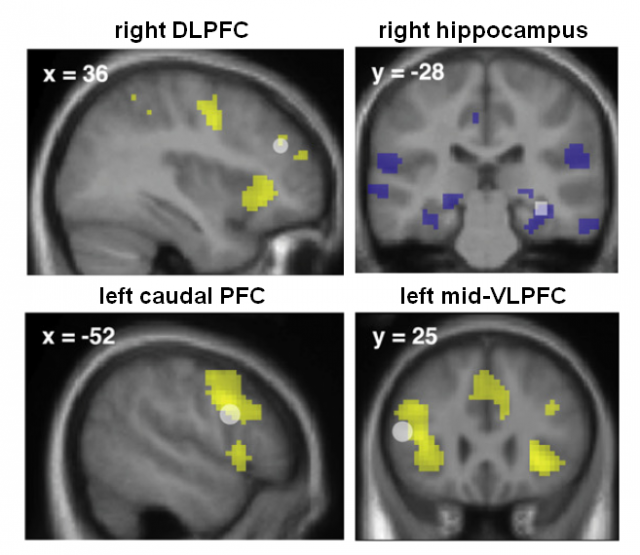Mapping areas involved in voluntary forgetting is not simple… it is double!

Most people consider forgetting things as a nuisance. Not remembering the name of someone we are supposed to remember or not knowing where we left the keys can be a little upsetting. But for some people, being unable to forget things can be really painful, and thus they try to voluntary eliminate their unpleasant memories. The commonest piece of advice that a friend would give you in that situation would be “don’t think about it” or “try to think about a different thing” –that is: try not to be aware of that memory.
Roland G. Benoit and Michael C. Anderson, from the MRC Cognition and Brain Sciences Unit in Cambridge (UK), explain 1 in the journal Neuron the brain mechanisms involved in the exclusion of an unwanted memory from awareness, those which impair the retention of that memory. The authors hypothesized two ways to induce forgetting. One of them involves a direct suppression of the memory retrieval (the “don’t think about it” way) and the other implies a thought substitution, where a second memory competes with the unwanted one to be in the focus of the awareness (the “try to think about a different thing” way).
The authors designed an experiment where the participants studied reminder-memory pairs (e.g., BEACH-AFRICA), and substituted memories for some of the reminders (e.g., BEACH-SNORKEL). Then, they were scanned by fMRI to determine the activity of different brain areas during the suppression phase. The participants were presented the reminders and they had to either recall the associated memory (if the reminder was in green colour) or to suppress it (red). One of the groups had to block the memories using direct suppression while the other used thought substitution. Finally, to determine the effectiveness of these mechanisms, the participants were asked to remember all the words they had studied. The results showed that both ways to induce forgetting had a significant effect on suppressing memories.

The authors then analyzed the brain scanners to determine the areas engaged in these mechanisms. The patients who used the direct suppression showed a significant decrease in the activity of the hippocampus, which was expected as this brain area is relevant for memory retrieval. They also showed a significant increase in the activity of the right Dorsolateral Prefrontal Cortex (DLPFC). Using dynamic causal modeling, the authors conclude that the activation of the DLPFC inhibits the hippocampal activity during the suppression of the memories. This DLPFC activation was greater in the participants who forgot more memories. Interestingly, previous studies had shown that patients suffering from posttraumatic stress disorder exhibit reduced DLPFC activity when presented with reminders of the traumatic experiences, which may explain why they are less able to forget the unwanted memories.
The thought substitution task involves retrieval of the substitute memory, so an activation of the hippocampus was expected, unlike in the direct suppression mechanism, and this hypothesis was confirmed with the fMRI scans. But then, a choice needs to be made between the unwanted memory and the alternative one, and the authors showed that two left prefrontal regions are responsible for such a selection. The caudal prefrontal cortex (cPFC) and the midventrolateral prefrontal cortex (mid-VLPFC) activity were significantly greater when the participants tried to suppress a memory than when they tried to recall it.
In conclusion, the authors describe two different mechanisms to avoid unwanted memories which have the same effect to induce voluntary forgetting, but through opposed neurocognitive pathways. Knowing the systems controlling unwanted memories might be very helpful to develop therapeutic strategies for patients who cannot regulate their memories, such as those suffering from posttraumatic stress disorder.
References
- R.G. Benoit & M.C. Anderson (2012) Opposing Mechanisms Support the Voluntary Forgetting of Unwanted Memories. Neuron 76: 450-460. DOI: 10.1016/j.neuron.2012.07.025 ↩
4 comments
Congrats, Moisés.
Thank you, Dani. I hope you enjoyed the article.
Great Moisés. It’s a very interesting article and I liked it a lot.
I wish you all the best in this new project.
I have read a few excellent stuff here. Definitely worth bookmarking for revisiting. I wonder how a lot attempt you set to create this kind of fantastic informative web site.